Large-Range Polymer Optical-Fiber Strain-Gauge Sensor for Elastic Tendons in Wearable Assistive Robots
Abstract
1. Introduction
2. Sensor System Requirements
2.1. Human Tendons and Bioinspiration
2.2. T-Flex Robotic Orthosis and Actuation System
2.3. POF Sensor Requirements
3. Materials and Methods
3.1. Sensor Operation Principle
3.2. Analytical Model
3.3. Experiment Protocol
4. Results and Discussion
5. Conclusions and Future Work
Author Contributions
Funding
Acknowledgments
Conflicts of Interest
Abbreviations
| POF | Polymer Optical Fiber |
| AFO | Ankle–Foot Orthoses |
References
- Polygerinos, P.; Correll, N.; Morin, S.A.; Mosadegh, B.; Onal, C.D.; Petersen, K.; Cianchetti, M.; Tolley, M.T.; Shepherd, R.F. Soft Robotics: Review of Fluid-Driven Intrinsically Soft Devices; Manufacturing, Sensing, Control, and Applications in Human-Robot Interaction. Adv. Eng. Mater. 2017, 19, 1700016. [Google Scholar] [CrossRef]
- Huo, W.; Mohammed, S.; Moreno, J.C.; Amirat, Y. Lower Limb Wearable Robots for Assistance and Rehabilitation: A State of the Art. IEEE Syst. J. 2016, 10, 1068–1081. [Google Scholar] [CrossRef]
- Viteckova, S.; Kutilek, P.; Jirina, M. Wearable lower limb robotics: A review. Biocybern. Biomed. Eng. 2013, 33, 96–105. [Google Scholar] [CrossRef]
- Mohammed, S.; Amirat, Y.; Rifai, H. Lower-Limb Movement Assistance through Wearable Robots: State of the Art and Challenges. Adv. Robot. 2012, 37–41. [Google Scholar] [CrossRef]
- Moreno, J.; Asin, G.; Pons, J.; Cuypers, H.; Vanderborght, B.; Lefeber, D.; Ceseracciu, E.; Reggiani, M.; Thorsteinsson, F.; Del-Ama, A.; et al. Symbiotic Wearable Robotic Exoskeletons: The Concept of the BioMot Project J.C.; Lecture Notes in Computer Science; Springer: Berlin/Heidelberg, Germany, 2014; Volume 8820, pp. 72–83. [Google Scholar] [CrossRef]
- Veale, A.J.; Xie, S.Q. Towards compliant and wearable robotic orthoses: A review of current and emerging actuator technologies. Med. Eng. Phys. 2016, 38, 317–325. [Google Scholar] [CrossRef]
- Albu-Schaffer, A.; Fischer, M.; Schreiber, G.; Schoeppe, F.; Hirzinger, G. Soft robotics: What Cartesian stiffness can obtain with passively compliant, uncoupled joints? In Proceedings of the 2004 IEEE/RSJ International Conference on Intelligent Robots and Systems (IROS), Sendai, Japan, 28 September–2 October 2004; pp. 3295–3301. [Google Scholar] [CrossRef]
- Zinn, M.; Khatib, O.; Roth, B.; Salisbury, J.K. A New Actuation Approach for Human Friendly Robot Design. Exp. Robot. VIII 2003, 5, 113–122. [Google Scholar] [CrossRef]
- Koganezawa, K.; Ban, S. Stiffness control of antagonistically driven redundant D.O.F. manipulator. In Proceedings of the IEEE/RSJ International Conference on Intelligent Robots and Systems, Lausanne, Switzerland, 30 September–4 October 2002; pp. 2280–2285. [Google Scholar] [CrossRef]
- Manti, B.M.; Cacucciolo, V.; Cianchetti, M. Stiffening in Soft Robotics. IEEE Robot. Autom. Mag. 2016, 23, 93–106. [Google Scholar] [CrossRef]
- Veneman, J.F.; Ekkelenkamp, R.; Kruidhof, R.; Van Der Helm, F.C.; Van Der Kooij, H. Design of a series elastic- and bowdencable-based actuation system for use as torque-actuator in exoskeleton-type training. In Proceedings of the 9th International Conference on Rehabilitation Robotics, Chicago, IL, USA, 28 June–1 July 2005; Volume 2005, pp. 496–499. [Google Scholar] [CrossRef]
- Kong, K.; Jeon, D. Design and control of an exoskeleton for the elderly and patients. IEEE/ASME Trans. Mechatron. 2006, 11, 428–432. [Google Scholar] [CrossRef]
- Tsagarakis, N.; Caldwell, D.G. Development and Control of a ‘Soft-Actuated’ Exoskeleton for Use in Physiotherapy and Training. Auton. Robot. 2003, 15, 21–33. [Google Scholar] [CrossRef]
- Costz, N.; Kousidou, S.; Caldwell, D.G.; Tsagarakits, N.G.; Sarakoglou, I. “Soft” Exoskeletons for Upper and Lower Body Rehabilitation—Design, Control and Testing. Int. J. Humanoid Robot. 2007, 4, 549–573. [Google Scholar] [CrossRef]
- Kim, J.; Hwang, S.; Sohn, R.; Lee, Y.; Kim, Y. Development of an active ankle foot orthosis to prevent foot drop and toe drag in hemiplegic patients: A preliminary study. Appl. Bionics Biomech. 2011, 8, 377–384. [Google Scholar] [CrossRef]
- Cain, S.M.; Gordon, K.E.; Ferris, D.P. Locomotor adaptation to a powered ankle-foot orthosis depends on control method. J. Neuroeng. Rehabil. 2007, 13, 1–13. [Google Scholar] [CrossRef] [PubMed]
- Manchola, M.; Serrano, D.; Daniel, G.; Ballen, F.; Casas, D.; Munera, M. Wearable Robotics: Challenges and Trends. In Proceedings of the 2nd International Symposium on Wearable Robotics—WeRob2016, Segovia, Spain, 18–21 October 2016; Volume 16, pp. 160–164. [Google Scholar] [CrossRef]
- Rossiter, J.; Hauser, H. Soft Robotics—The Next Industrial Revolution? [Industrial Activities]. IEEE Robot. Autom. Mag. 2016, 23, 17–20. [Google Scholar] [CrossRef]
- Leal-Junior, A.; Casas, J.; Marques, C.; Pontes, M.; Frizera, A.; Leal-Junior, A.; Casas, J.; Marques, C.; Pontes, M.J.; Frizera, A. Application of Additive Layer Manufacturing Technique on the Development of High Sensitive Fiber Bragg Grating Temperature Sensors. Sensors 2018, 18, 4120. [Google Scholar] [CrossRef] [PubMed]
- Goldfield, E.C.; Park, Y.L.; Chen, B.R.; Hsu, W.H.; Young, D.; Wehner, M.; Kelty-Stephen, D.G.; Stirling, L.; Weinberg, M.; Newman, D.; et al. Bio-Inspired Design of Soft Robotic Assistive Devices: The Interface of Physics, Biology, and Behavior. Ecol. Psychol. 2012, 24, 300–327. [Google Scholar] [CrossRef]
- Pinet, É. Fabry-Pérot Fiber-Optic Sensors for Physical Parameters Measurement in Challenging Conditions. J. Sens. 2009, 2009, 1–9. [Google Scholar] [CrossRef]
- Leal-Junior, A.G.; Frizera, A.; Vargas-Valencia, L.; Dos Santos, W.M.; Bo, A.P.; Siqueira, A.A.; Pontes, M.J. Polymer Optical Fiber Sensors in Wearable Devices: Toward Novel Instrumentation Approaches for Gait Assistance Devices. IEEE Sens. J. 2018, 18, 7085–7092. [Google Scholar] [CrossRef]
- James, S.W.; Tatam, R.P. Optical fibre long-period grating sensors: Characteristics and application. Meas. Sci. Technol. 2003, 14, R49–R61. [Google Scholar] [CrossRef]
- Patrick, H.; Williams, G.; Kersey, A.; Pedrazzani, J.; Vengsarkar, A. Hybrid fiber Bragg grating/long period fiber grating sensor for strain/temperature discrimination. IEEE Photonics Technol. Lett. 1996, 8, 1223–1225. [Google Scholar] [CrossRef]
- Chan, T.; Yu, L.; Tam, H.; Ni, Y.; Liu, S.; Chung, W.; Cheng, L. Fiber Bragg grating sensors for structural health monitoring of Tsing Ma bridge: Background and experimental observation. Eng. Struct. 2006, 28, 648–659. [Google Scholar] [CrossRef]
- Guo, T.; Liu, F.; Guan, B.O.; Albert, J. Tilted fiber grating mechanical and biochemical sensors. Opt. Laser Technol. 2016, 78, 19–33. [Google Scholar] [CrossRef]
- Shao, L.Y.; Albert, J. Lateral force sensor based on a core-offset tilted fiber Bragg grating. Opt. Commun. 2011, 284, 1855–1858. [Google Scholar] [CrossRef]
- James, S.; Dockney, M.; Tatam, R. Simultaneous independent temperature and strain measurement using in-fibre Bragg grating sensors. Electron. Lett. 1996, 32, 1133. [Google Scholar] [CrossRef]
- Bilro, L.; Alberto, N.; Pinto, J.L.; Nogueira, R. Optical sensors based on plastic fibers. Sensors (Switzerland) 2012, 12, 12184–12207. [Google Scholar] [CrossRef] [PubMed]
- Dunne, L.E.; Walsh, P.; Smyth, B.; Caulfield, B. Design and evaluation of a wearable optical sensor for monitoring seated spinal posture. In Proceedings of the 2006 10th IEEE International Symposium on Wearable Computers, Montreux, Switzerland, 11–14 October 2006; pp. 65–68. [Google Scholar] [CrossRef]
- Zhao, B.H.; Jalving, J.; Huang, R.; Knepper, R.; Ruina, A.; Shepherd, R. A Helping Hand: Soft Orthosis with Integrated Optical Strain Sensors and EMG Control. IEEE Robot. Autom. Mag. 2016, 23, 55–64. [Google Scholar] [CrossRef]
- Jae Yoo, W.; Won Jang, K.; Ki Seo, J.; Yeon Heo, J.; Soo Moon, J.; Park, J.Y.; Lee, B. Development of Respiration Sensors Using Plastic Optical Fiber for Respiratory Monitoring Inside MRI System. J. Opt. Soc. Korea 2010, 14, 235–239. [Google Scholar] [CrossRef]
- Grillet, A.; Kinet, D.; Witt, J.; Schukar, M.; Krebber, K.; Pirotte, F.; Depré, A. Optical Fiber Sensors Embedded Into Medical Textiles for Healthcare Monitoring. IEEE Sens. J. 2008, 8, 1215. [Google Scholar] [CrossRef]
- Harnett, C.K.; Zhao, H.; Shepherd, R.F. Stretchable Optical Fibers: Threads for Strain-Sensitive Textiles. Adv. Mater. Technol. 2017, 2, 1–7. [Google Scholar] [CrossRef]
- Optoelectronically Innervated Soft Prosthetic Hand via Stretchable Optical Waveguides. Available online: https://pdfs.semanticscholar.org/70c4/4a842f20ff3c45d74d6e2e6653bcc40ef388.pdf (accessed on 1 April 2019).
- Guo, J.; Liu, X.; Jiang, N.; Yetisen, A.K.; Yuk, H.; Yang, C.; Khademhosseini, A.; Zhao, X.; Yun, S.H. Highly Stretchable, Strain Sensing Hydrogel Optical Fibers. Adv. Mater. 2016, 28, 10244–10249. [Google Scholar] [CrossRef] [PubMed]
- Taffoni, F.; Formica, D.; Saccomandi, P.; Pino, G.; Schena, E.; Taffoni, F.; Formica, D.; Saccomandi, P.; Pino, G.D.; Schena, E. Optical Fiber-Based MR-Compatible Sensors for Medical Applications: An Overview. Sensors 2013, 13, 14105–14120. [Google Scholar] [CrossRef] [PubMed]
- To, C.; Hellebrekers, T.; Jung, J.; Yoon, S.J.; Park, Y.L. A Soft Optical Waveguide Coupled With Fiber Optics for Dynamic Pressure and Strain Sensing. IEEE Robot. Autom. Lett. 2018, 3, 3821–3827. [Google Scholar] [CrossRef]
- Leal-Junior, A.G.; Frizera, A.; Marques, C.; Sánchez, M.R.; Botelho, T.R.; Segatto, M.V.; Pontes, M.J. Polymer optical fiber strain gauge for human-robot interaction forces assessment on an active knee orthosis. Opt. Fiber Technol. 2018, 41, 205–211. [Google Scholar] [CrossRef]
- Vallan, A.; Casalicchio, M.L.; Olivero, M.; Perrone, G. Assessment of a Dual-Wavelength Compensation Technique for Displacement Sensors Using Plastic Optical Fibers. IEEE Trans. Instrum. Meas. 2012, 61, 1377–1383. [Google Scholar] [CrossRef]
- Zawawi, M.A.; O’Keeffe, S.; Lewis, E. Plastic optical fibre sensor for spine bending monitoring with power fluctuation compensation. Sensors (Switzerland) 2013, 13, 14466–14483. [Google Scholar] [CrossRef]
- Beach, Z.M.; Gittings, D.J.; Soslowsky, L.J. Muscle and Tendon Injuries. Med. Sci. Sports Exerc. 2018, 50, 388. [Google Scholar] [CrossRef]
- Svensson, R.B.; Hassenkam, T.; Hansen, P.; Peter Magnusson, S. Viscoelastic behavior of discrete human collagen fibrils. J. Mech. Behav. Biomed. Mater. 2010, 3, 112–115. [Google Scholar] [CrossRef] [PubMed]
- Atkinson, T.S.; Ewers, B.J.; Haut, R.C. The tensile and stress relaxation responses of human patellar tendon varies with specimen cross-sectional area. J. Biomech. 1999, 32, 907–914. [Google Scholar] [CrossRef]
- Wren, T.A.L.; Yerby, S.A.; Beaupr, G.S.; Carter, D.R.; Beaupré, G.S. Mechanical properties of the human achilles tendon. Clin. Biomech. 2001, 16, 245–251. [Google Scholar] [CrossRef]
- Petit, F.; Chalon, M.; Friedl, W.; Grebenstein, M.; Albu-sch, A. Bidirectional Antagonistic Variable Stiffness Actuation: Analysis, Design & Implementation. In Proceedings of the 2010 IEEE International Conference on Robotics and Automation, Anchorage, AK, USA, 3–7 May 2010; pp. 4189–4196. [Google Scholar]
- Bonsignorio, F.; Cangelosi, A. Co-exploring Actuator Antagonism and Bio-inspired Control in a Printable Robot Arm. In Proceedings of the 14th International Conference on Simulation of Adaptive Behavior, SAB 2016, Aberystwyth, UK, 23–26 August 2016; Volume 1, pp. 244–255. [Google Scholar] [CrossRef]
- Kiesel, S.; Peters, K.; Hassan, T.; Kowalsky, M. Behaviour of intrinsic polymer optical fibre sensor for large-strain applications. Meas. Sci. Technol. 2007, 18, 3144–3154. [Google Scholar] [CrossRef]
- Krebber, K.; Lenke, P.; Liehr, S.; Witt, J.; Schukar, M. Smart technical textiles with integrated POF sensors. Proc. SPIE 6933 Smart Sens. Phenom. Technol. Netw. Syst. 2008, 6933, 69330V. [Google Scholar] [CrossRef]
- Welker, D.J.; Johns, W.E.; Jiang, C.; Ding, J.L.; Kuzyk, M.G. Fabrication and mechanical behavior of dye-doped polymer optical fiber. J. Appl. Phys. 2002, 92, 4–12. [Google Scholar] [CrossRef]
- Antunes, P.F.C.; Varum, H.; Andre, P.S. Intensity-encoded polymer optical fiber accelerometer. IEEE Sens. J. 2013, 13, 1716–1720. [Google Scholar] [CrossRef]
- Ziemann, Q.; Krauser, J.; Zamzow, P.E. POF Handbook—Optical Short Range Transmission Systems; Springer: Berlin/Heidelberg, Germany, 2008; p. 455. [Google Scholar]
- Sánchez-Manchola, M.; Gómez-Vargas, D.; Casas-Bocanegra, D.; Múnera, M.; Cifuentes, C.A. Development of a Robotic Lower-Limb Exoskeleton for Gait Rehabilitation: AGoRA Exoskeleton. In Proceedings of the 2018 IEEE ANDESCON, Santiago de Cali, Colombia, 22–24 August 2018; pp. 1–6. [Google Scholar] [CrossRef]
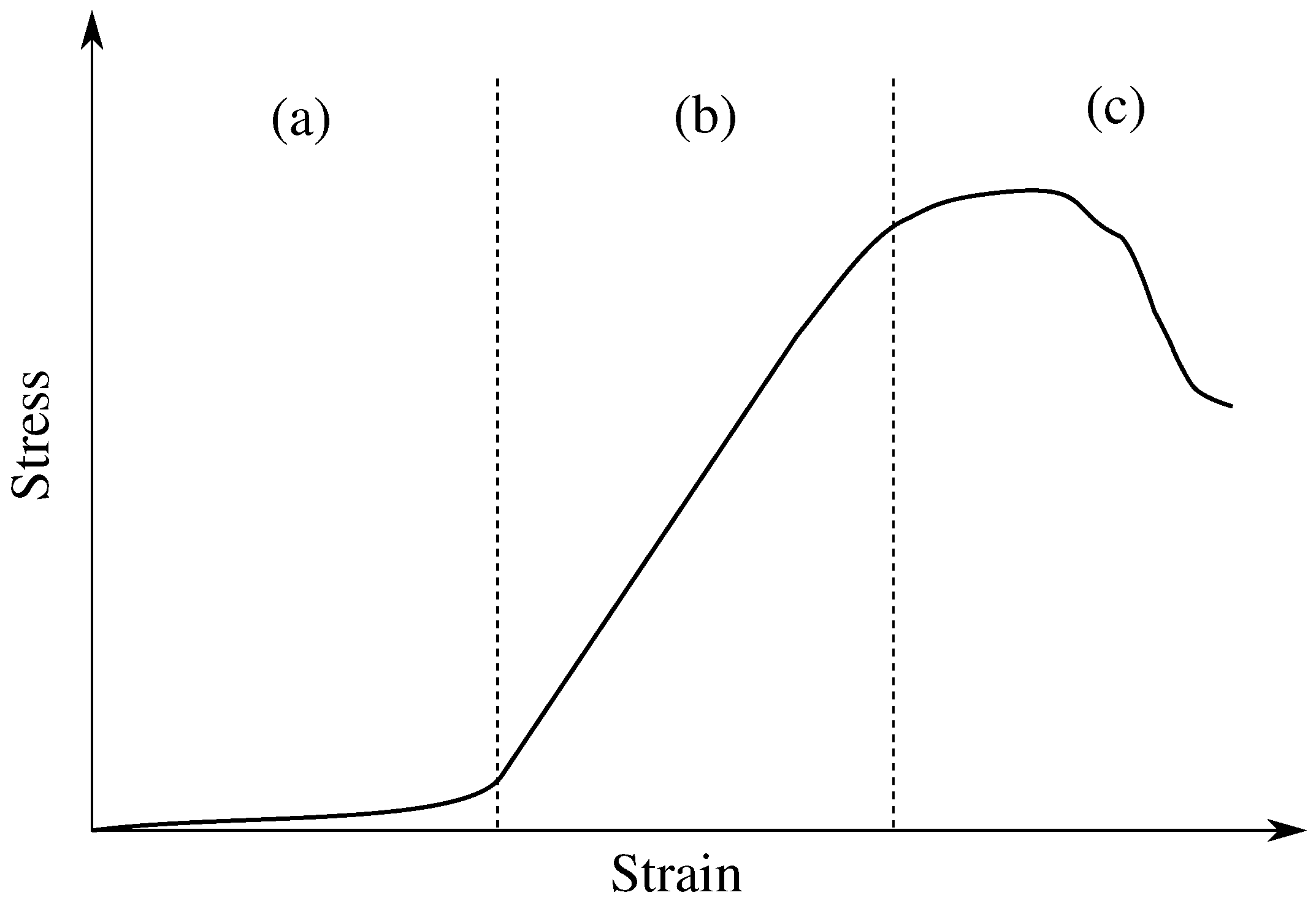

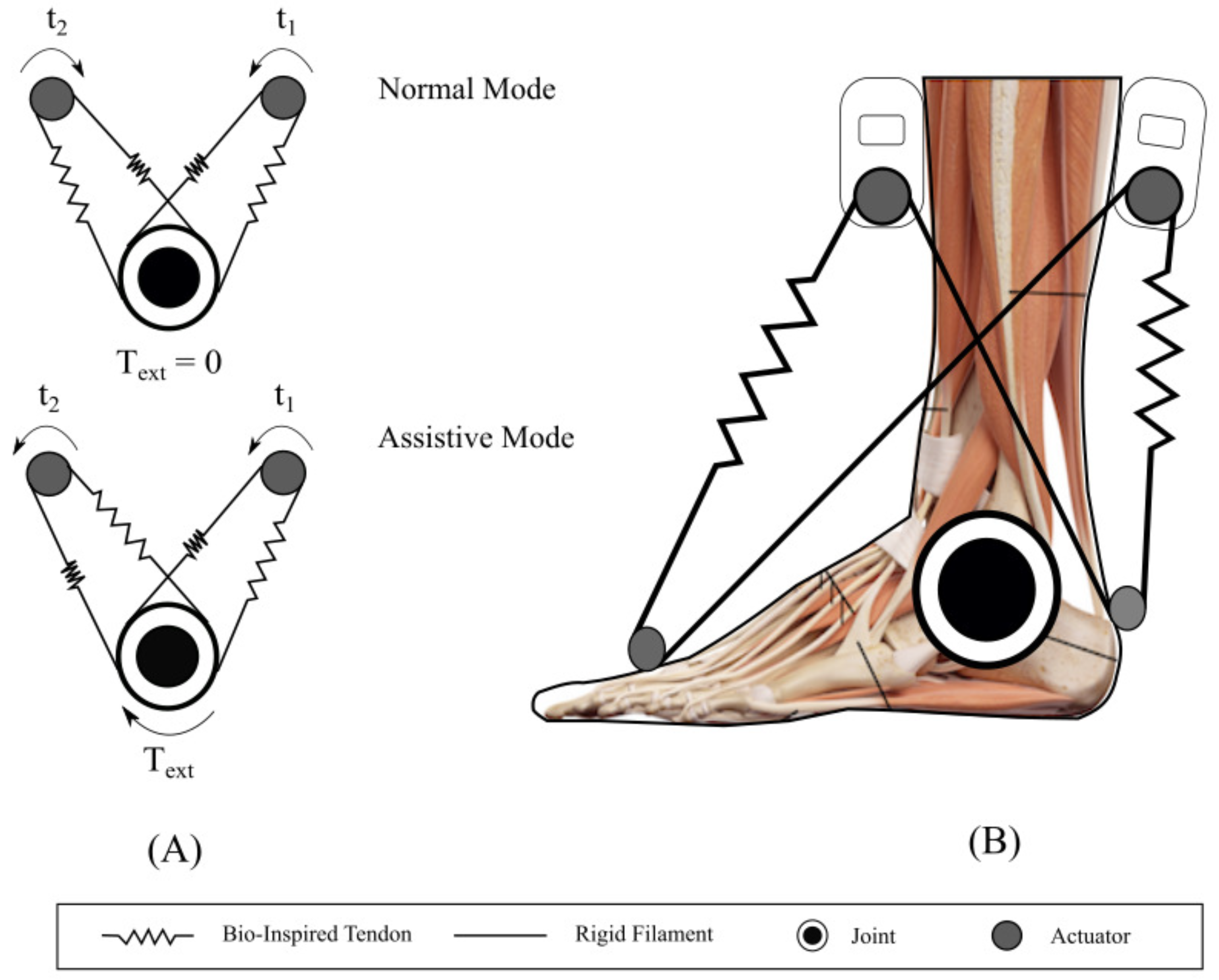
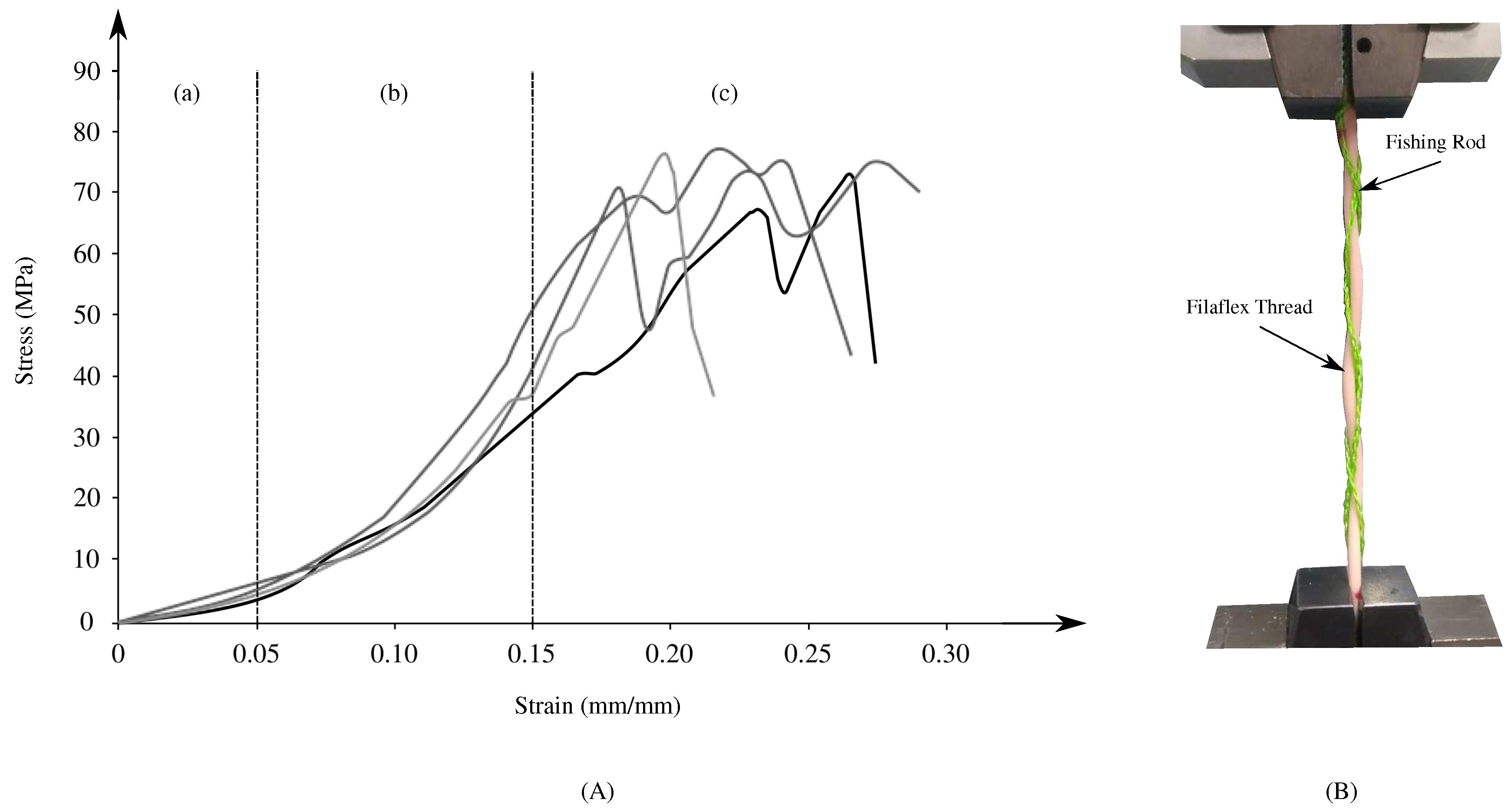
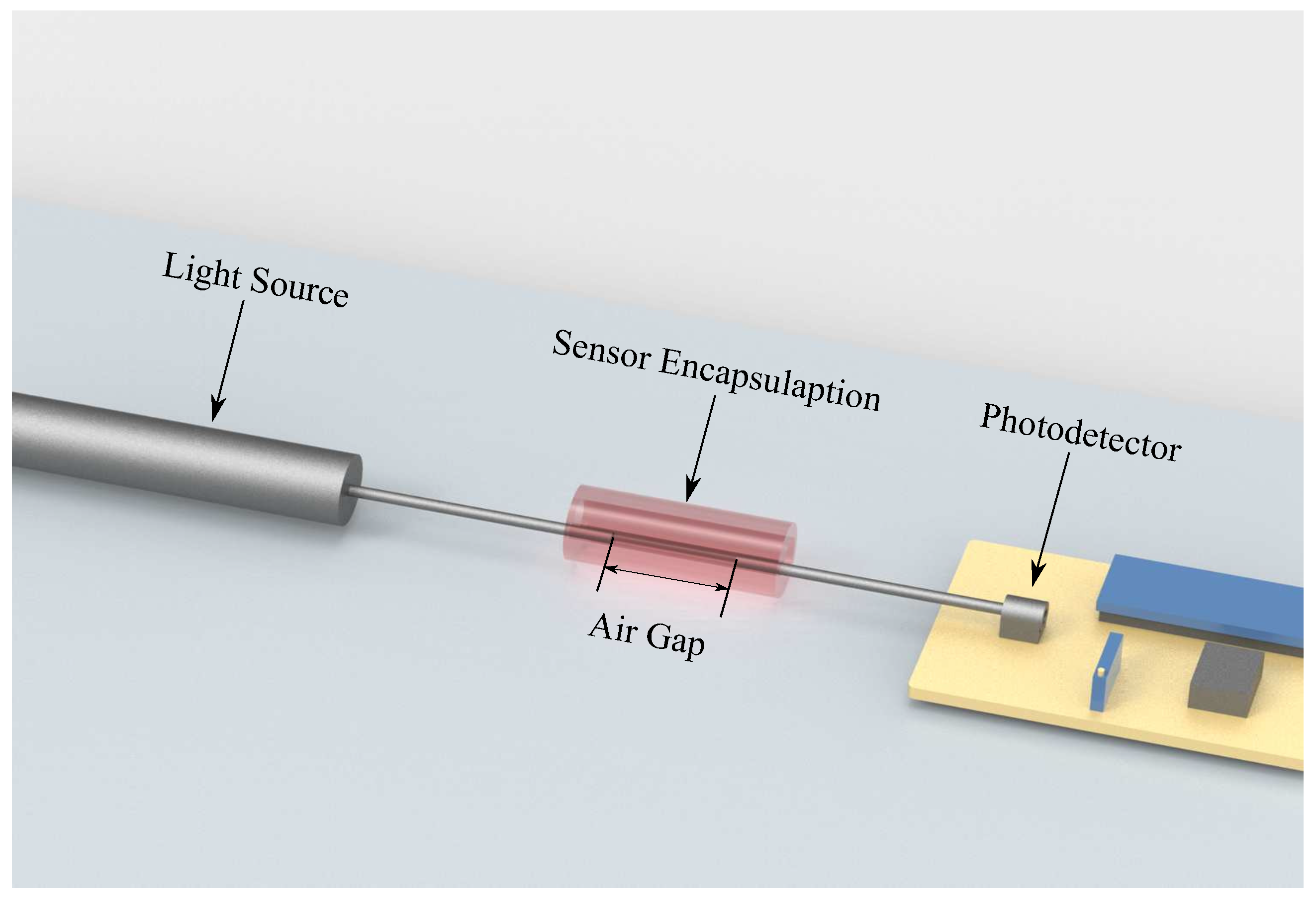
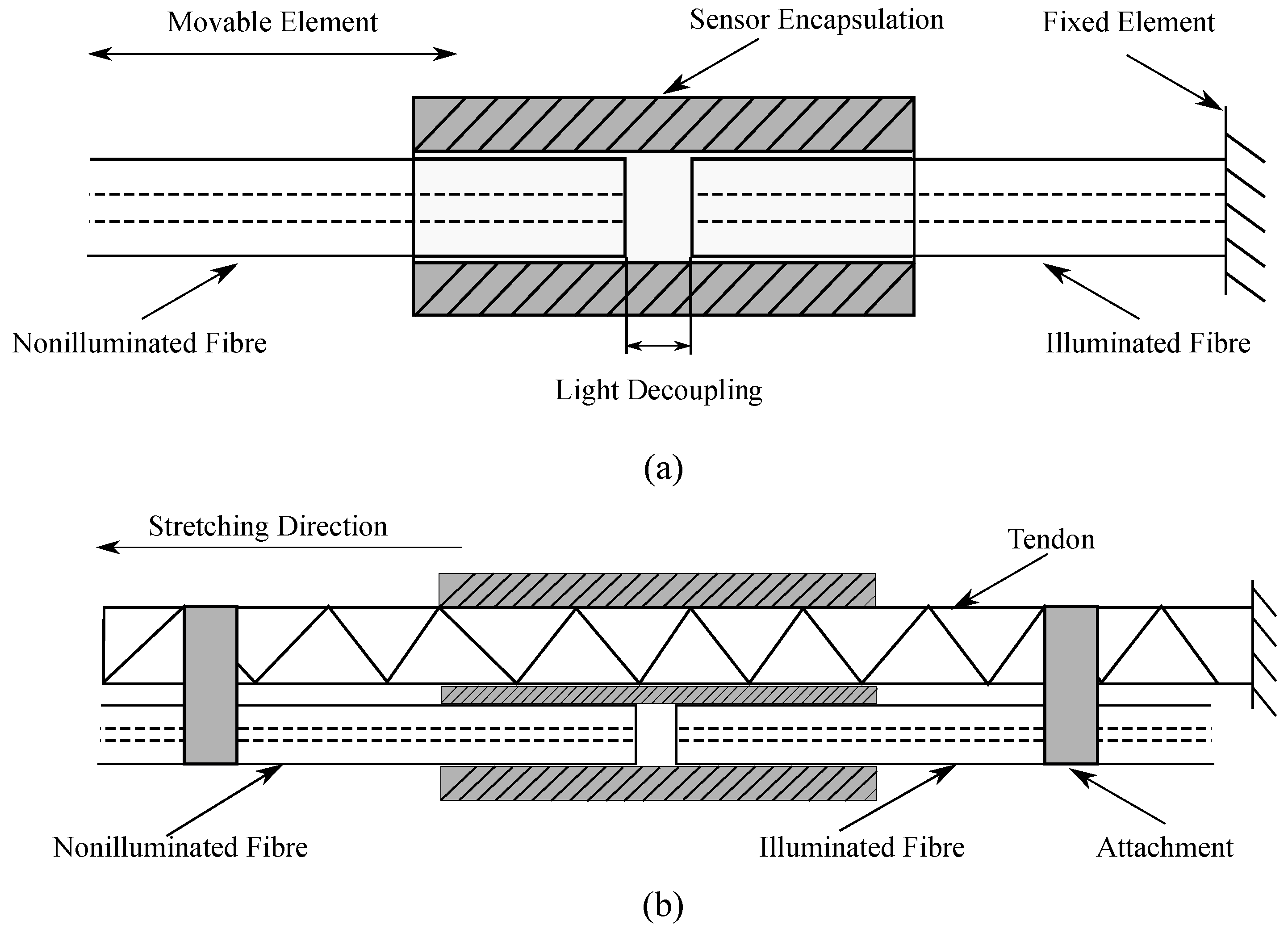
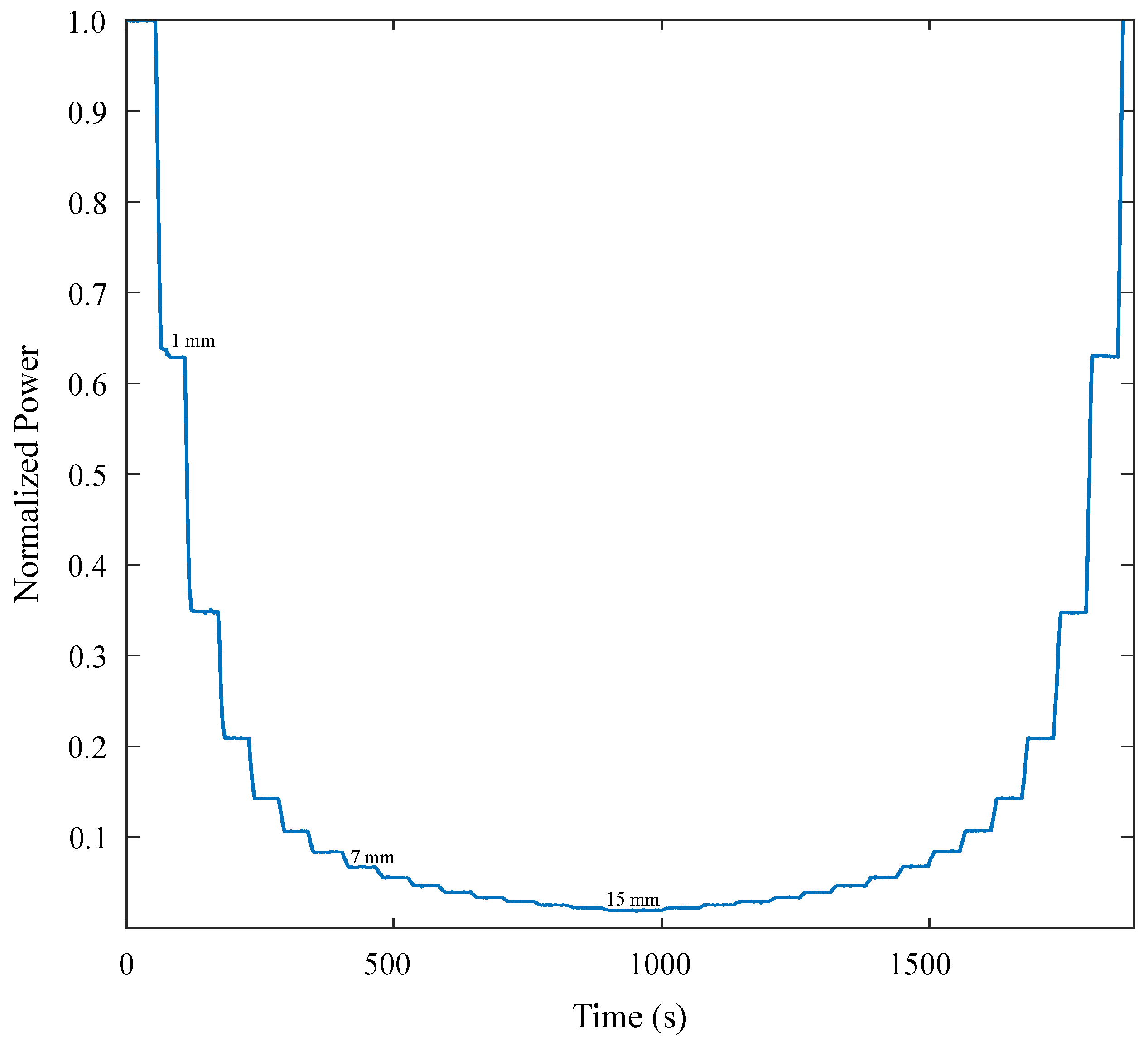
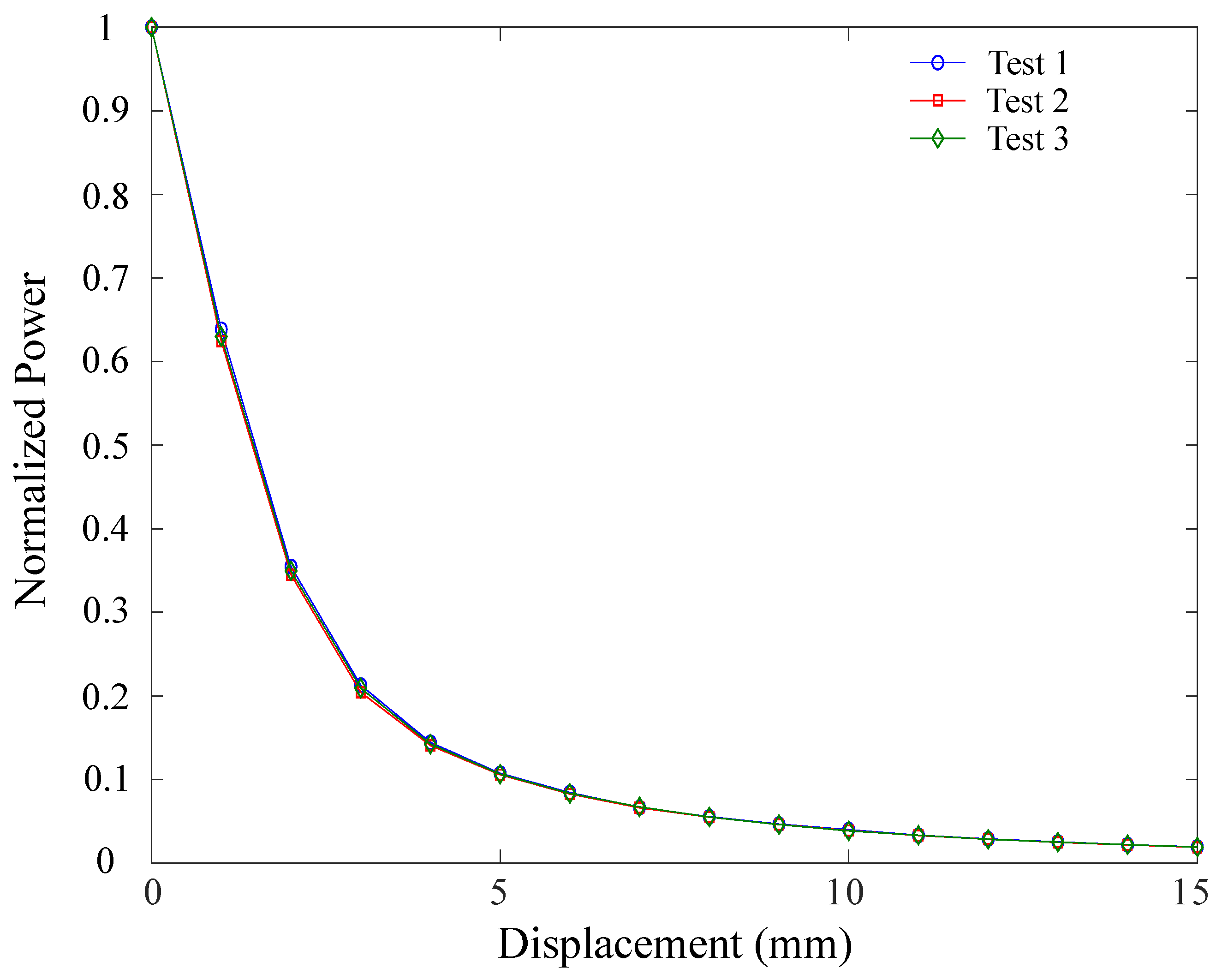
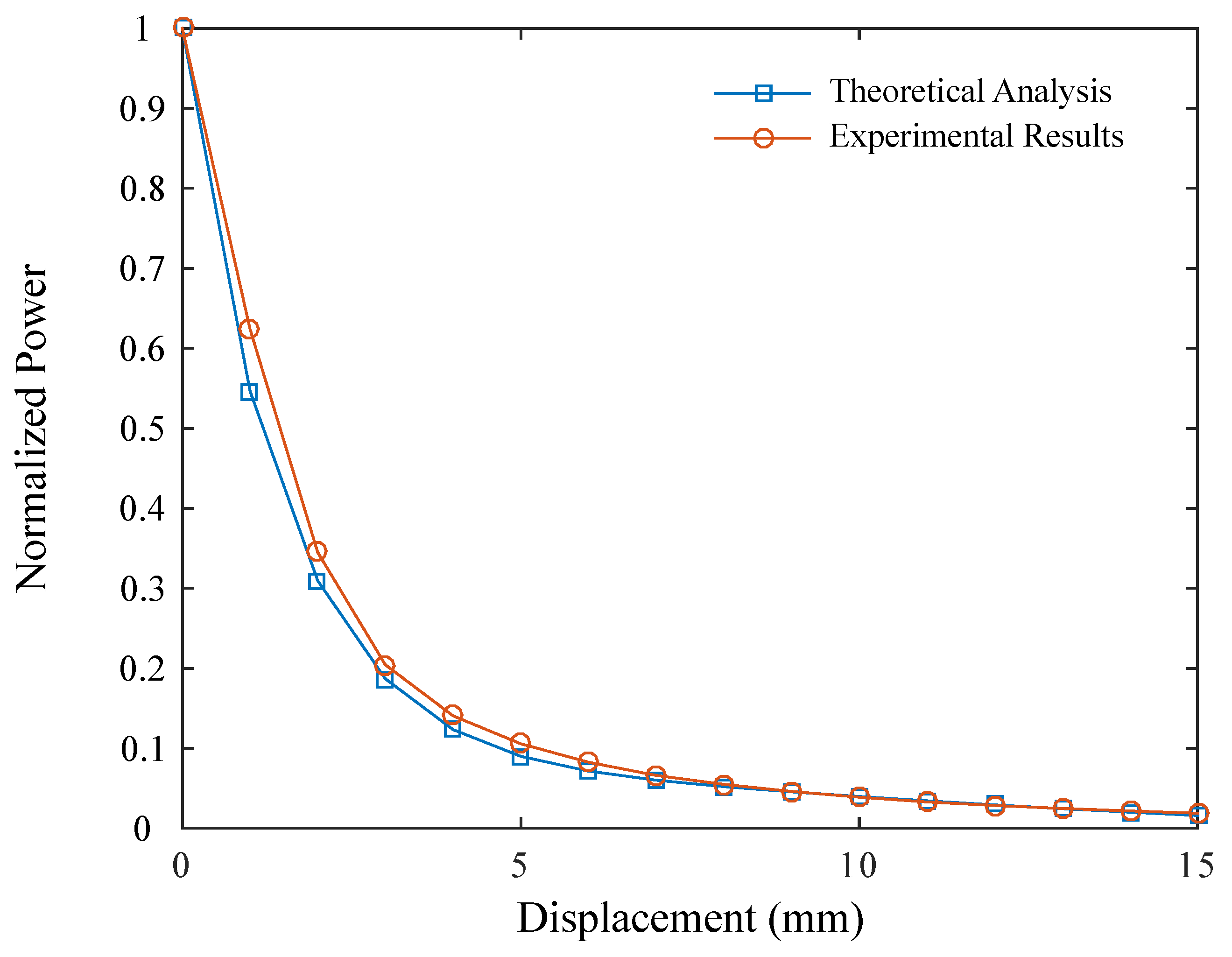
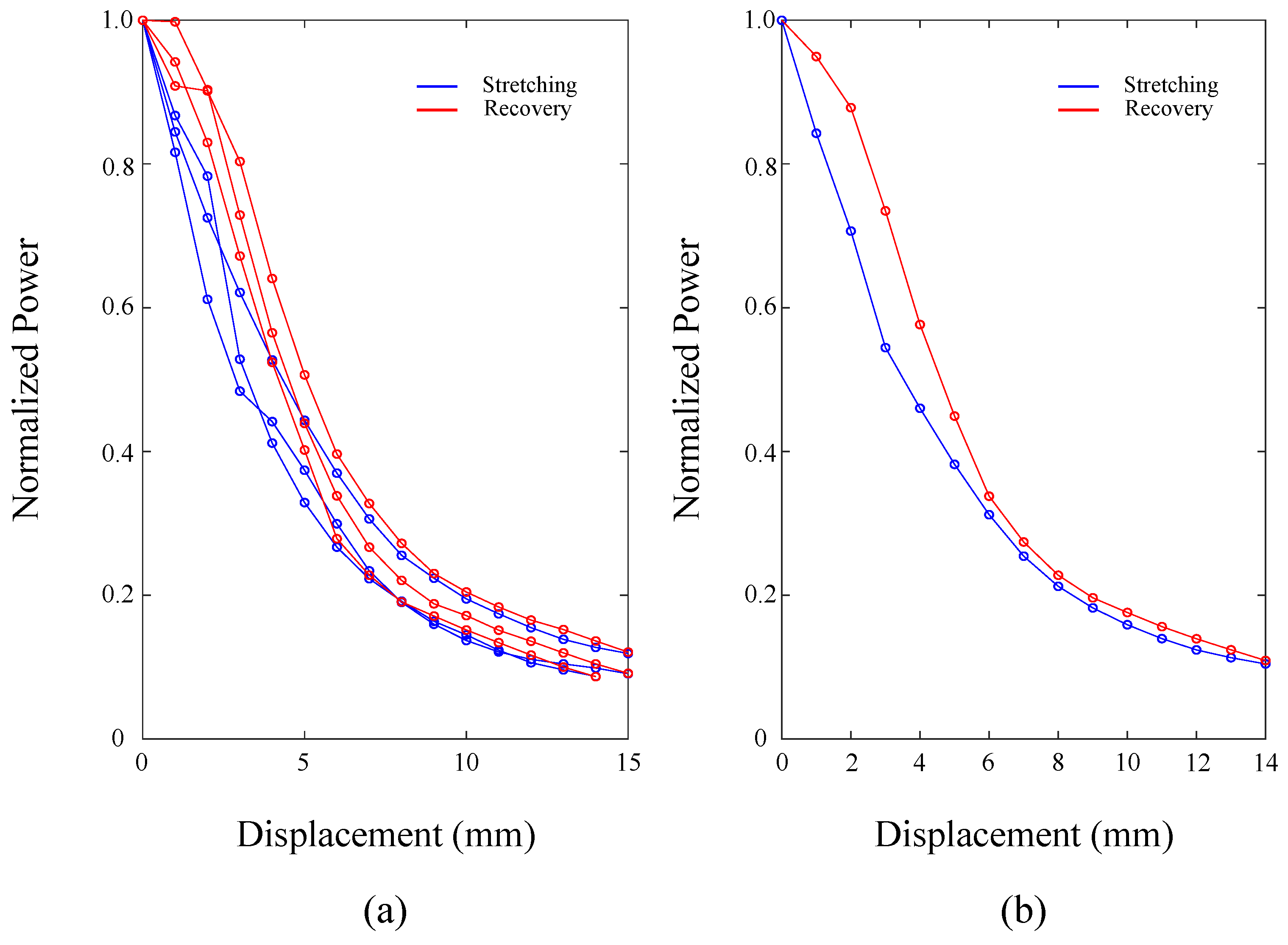
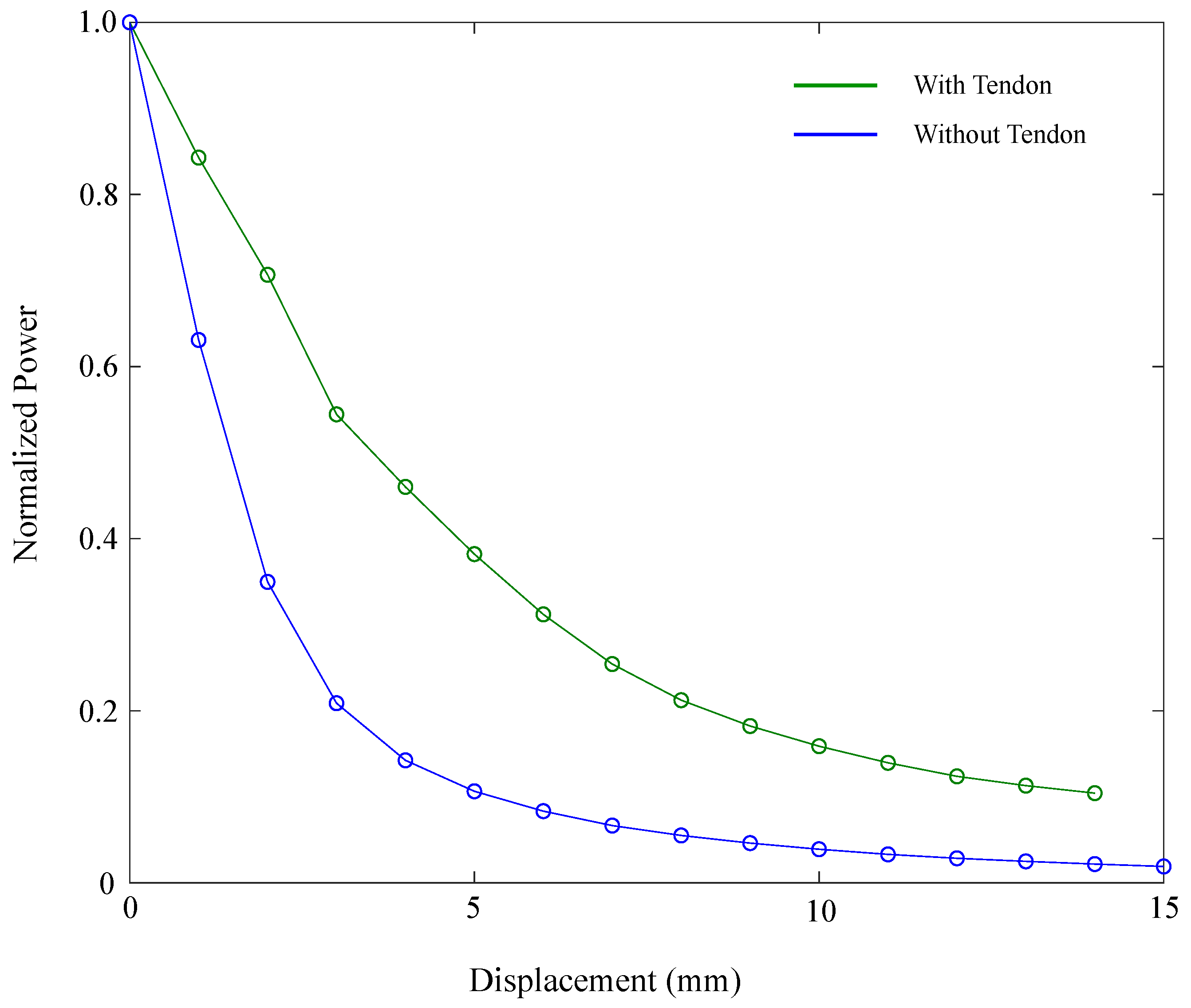
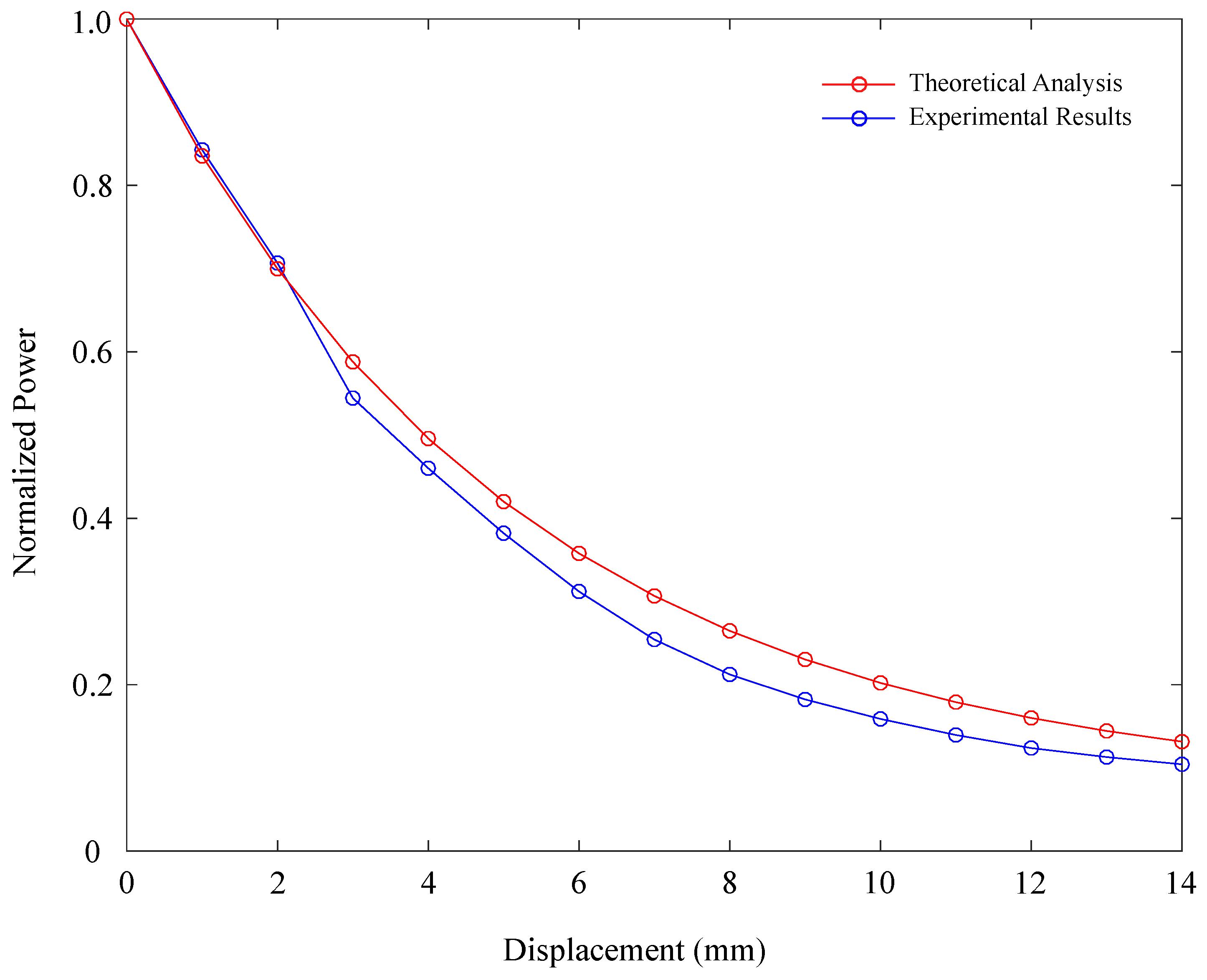
| POF | Elastic Tendon | ||
|---|---|---|---|
| Strain Range (%) | Modulus (GPa) | Strain Range (%) | Modulus (MPa) |
| 0–1.0 | 3.96 | 0–10 | 150 |
| 1.0–3.0 | 4.34 | 10–15 | 500 |
| 3.0–5.0 | 5.04 | >15 | 500–600 |
| Symbol | Parameter | Value |
|---|---|---|
| a | Fiber radius | 0.5 mm |
| Medium refractive index | 1.0003 | |
| l | Lateral misalignment | 0.5 mm |
| Angular misalignment | 0 rad | |
| Fiber numerical aperture | 0.47 | |
| POF attenuation coefficient | 12 dB/km |
© 2019 by the authors. Licensee MDPI, Basel, Switzerland. This article is an open access article distributed under the terms and conditions of the Creative Commons Attribution (CC BY) license (http://creativecommons.org/licenses/by/4.0/).
Share and Cite
Casas, J.; Leal-Junior, A.; Díaz, C.R.; Frizera, A.; Múnera, M.; Cifuentes, C.A. Large-Range Polymer Optical-Fiber Strain-Gauge Sensor for Elastic Tendons in Wearable Assistive Robots. Materials 2019, 12, 1443. https://doi.org/10.3390/ma12091443
Casas J, Leal-Junior A, Díaz CR, Frizera A, Múnera M, Cifuentes CA. Large-Range Polymer Optical-Fiber Strain-Gauge Sensor for Elastic Tendons in Wearable Assistive Robots. Materials. 2019; 12(9):1443. https://doi.org/10.3390/ma12091443
Chicago/Turabian StyleCasas, Jonathan, Arnaldo Leal-Junior, Camilo R. Díaz, Anselmo Frizera, Marcela Múnera, and Carlos A. Cifuentes. 2019. "Large-Range Polymer Optical-Fiber Strain-Gauge Sensor for Elastic Tendons in Wearable Assistive Robots" Materials 12, no. 9: 1443. https://doi.org/10.3390/ma12091443
APA StyleCasas, J., Leal-Junior, A., Díaz, C. R., Frizera, A., Múnera, M., & Cifuentes, C. A. (2019). Large-Range Polymer Optical-Fiber Strain-Gauge Sensor for Elastic Tendons in Wearable Assistive Robots. Materials, 12(9), 1443. https://doi.org/10.3390/ma12091443







